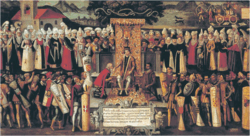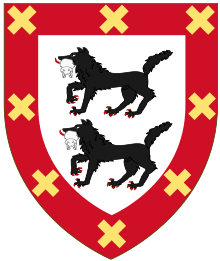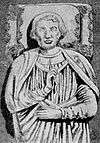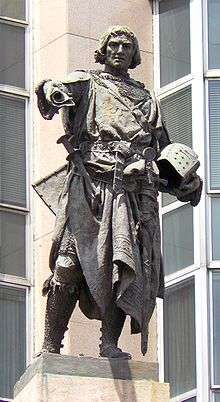Lord of Biscay

Lord of Biscay (Basque: Bizkaiko Jauna, Spanish: Señor de Vizcaya) is the historical title of the Lordship of Biscay, a feudal territory in present-day Biscay, in the Basque Country.
History
The first known Lord of Biscay (11th century), Íñigo López "Ezkerra" was a lieutenant of the Kingdom of Pamplona (later known as Navarre); this feudal relationship was intermittently held to by his successors until the definitive Castilian conquest of Gipuzkoa in 1200. The relations of the lords with the kings of Castille made them the landlords of Haro, La Rioja because they had favored the Castilian interests in the conflicts with Pamplona/Navarre.
The Lords had limited powers and had, like the Navarrese monarchs before them, to give oath at Gernika of respecting the fuero (Basque: forua), which in this context means a compilation of laws, when inheriting the honor.
After the Lordship was inherited by the Castilian dynasty in 1370, the Kings of Castile (and later, of Spain) still had to give oath in equal manner and so they did, until the Biscayan fueros were unilaterally supplanted at the end of 19th century, as a retaliatory measure from the government of Madrid for the support of the provinces to the Carlist pretender to the Crown.[1] They haven't done it since the second restoration of Alfonso XII
List of Lords of Biscay

Mythical
According to Lope García de Salazar, author of the historical Bienandanzas e fortunas (15th Century), there were at least five mythical or legendary lords of Biscay before the ones that can actually be considered historical and documented.
- Jaun Zuria (the White Lord): supposedly born from the union of god Sugaar and a Scottish (or Irish, or Danish, or Frankish) princess in the village of Mundaka. Legend says that Jaun Zuria was the elected chief of the Biscayans in the victorious battle of Arrigorriaga against the invading forces of the Kingdom of Asturias; tradition holds that before the battle he saw two wolves carrying lambs in their mouths, presaging the victory; this scene is reflected in the arms of the lords of Biscay of the House of Haro.
- Munio López (909-920), the son of Jaun Zuria, who married Belasquita, daughter of Sancho I of Pamplona.[2]
- Íñigo López Esquira (920-965), the step-brother of Munio López and called "the left-handed".
- Lope II Íñiguez (965-1011)
- Sancho López (1011-1016)
Historical
House of Haro
| Name | Portrait | Birth | Marriages | Death |
|---|---|---|---|---|
| Íñigo López Ezkerra (The Left-Handed) 1040-1077 | Unknown | Toda Fórtunez[3][4] five children | 1077 | |
| Lope Íñiguez 1077-1093 | 1050 Son of Íñigo López and Toda Fórtunez | Ticlo Díaz[5] five children | 1093 | |
| Diego López the White 1093-1124 | 1075 Son of Lope Íñiguez and Ticlo Díaz | María Sánchez three children | 1124 |
House of Vela
| Name | Portrait | Birth | Marriages | Death |
|---|---|---|---|---|
| Íñigo Vélaz 1124-c. 1131 | Unknown Son of Vela Aznarez | Unknown | c. 1131 | |
| Ladrón Íñiguez Prince of the Navarrese c. 1131-1155 | Unknown Son of Íñigo Vela and Áurea Jiménez | Unknown Three children | 1155 | |
| Vela Ladrón Vela from Navarre 1155-1162 | 1115 Son of Ladrón Íñiguez | Unknown | 1174 |
House of Haro (restored, first time)
| Name | Portrait | Birth | Marriages | Death |
|---|---|---|---|---|
| Lope Díaz the one from Nájera 1162-1170 | Unknown Son of Diego López and María Sánchez | Aldonza[6] eleven children | 6 May 1170 | |
| Diego López II the Good 1170-1214 |  | 1152 Lope Díaz and Aldonza | (1) María Manrique de Lara one children (2)Toda Pérez de Azagra seven children | 16 September 1214 |
| Lope Díaz II Brave Head 1214-1236 | 1170 Son of Diego López II and María Manrique de Lara | Urraca Alfonso de León 10 children[7] | 15 November 1236 | |
| Diego López III 1236-1254 | Unknown Son of Lope Díaz II and Urraca Alfonso de León | Constanza de Béarn five children | 4 October 1254 | |
| Lope Díaz III 1254-1288 | Unknown Son of Diego López III and Constanza de Béarn | Juana Alfonso de Molina two children | 8 June 1288 | |
| Diego López IV the Young 1288-1289 | Unknown Son of Lope Díaz III and Juana Alfonso de Molina | Unmarried | 1289 | |
| María Díaz the Good 1289-1295 | 1270 Daughter of Lope Díaz III and Juana Alfonso de Molina | Juan de Castile three children | 1342 | |
| Diego López V the Intruder 1295-1310 |  | 1250 Son of Diego López III and Constanza de Béarn | Violante de Castile four children | 1310 |
| María Díaz the Good 1310-1322 (second lordship) | 1270 Daughter of Lope Díaz III and Juana Alfonso de Molina | Juan of Castile three children | 1342 | |
| Juan the One-eyed 1322-1326 | Unknown Son of Juan of Castile and María Díaz | Isabel of Portugal and Manuel one children | 31 October 1326 | |
| María Díaz the Good 1326-1333 (third lordship) | 1270 Daughter of Lope Díaz III and Juana Alfonso de Molina | Juan of Castile three children | 1342 |
House of Burgundy (restored)
| Name | Portrait | Birth | Marriages | Death |
|---|---|---|---|---|
| Alfonso XI 1333-1334 |  | 1311 Son of Ferdinand IV of Castile and Constance of Portugal | Maria of Portugal two children | 1350 |
House of Haro (restored, second time)
| Name | Portrait | Birth | Marriages | Death |
|---|---|---|---|---|
| María Díaz II 1334-1349 | Unknown Daughter of Juan de Castilla y Haro and Isabel of Portugal and Manuel | Juan Núñez III de Lara five children | 1348-49 |
House of Lara
| Name | Portrait | Birth | Marriages | Death |
|---|---|---|---|---|
| Juan Núñez III 1334-1350 | 1314-15 Son of Ferdinand de la Cerda and Juana de Lara | María Díaz II de Haro five children | 1350 | |
| Nuño de Lara 1351-1352 | 1348 Son of Juan Núñez III de Lara and María Díaz II de Haro | Unmarried | 1352 | |
| Juana de Lara 1352-1359 | 1335 Daughter of Juan Núñez III de Lara and María Díaz II de Haro | Tello Alfonso no children | 1359 |
House of Trastámara
| Name | Portrait | Birth | Marriages | Death |
|---|---|---|---|---|
| Tello Alfonso 1355-1369 | 1337 Son of Alfonso XI of Castile and Eleanor de Guzmán | Juana de Lara no children | 1370 | |
| John I of Castile 1369-1379 | | 1358 Son of Henry II of Castile and Juana Manuel | Eleanor of Aragon two children | 1390 |
Starting with John I, the title of Lord of Biscay got integrated in the Crown of Castile, and ever since the monarchs of Castile, and later Spain, have also upheld the title of Lord of Biscay. The title is currently held by Felipe VI of Spain.
See also
References
- ↑ Trask, L. The History of Basque Routledge: 1997 ISBN 0-415-13116-2
- ↑ Título de cómo fue don Munso López, su fijo, segundo Señor de Vizcaya en de las Bienandanzas...
- ↑ Martín Duque 2002, p. 898.
- ↑ Balparda de las Herrerías 1933-34, p. 164.
- ↑ Balparda de las Herrerías 1933-34, pp. 257 and 259.
- ↑ Salazar y Acha 1985, pp. 57-60.
- ↑ Real Academia de Historia, Colección Salazar y Castro, Ref. M-8, fº 63v-64
Bibliography
- Balparda y las Herrerías, Gregorio de (1933–34). Historia crítica de Vizcaya y de sus Fueros. II, Libro III. El primer fuero de Vizcaya , el de los Señores. Bilbao: Imprenta Mayli. OCLC 634212337.
- Martín Duque, Ángel J. (2002). "Vasconia en la alta edad media: somera aproximación histórica". Príncipe de Viana (in Spanish). Pamplona: Gobierno de Navarra: Institución Príncipe de Viana (227): 871–908. ISSN 0032-8472.
- Salazar y Acha, Jaime de (1985). Una Familia de la Alta Edad Media: Los Velas y su Realidad Histórica (en Estudios Genealógicos y Heráldicos). Asociación Española de Estudios Genealógicos y Heráldicos. ISBN 84-398-3591-4.
- Historia de Navarra, el estado vasco, Mikel Sorauren, 1998.
External links
Coordinates: 43°02′00″N 2°37′00″W / 43.0333°N 2.6167°W